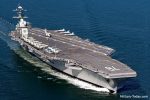IN 2009, the U.S. Navy finally began construction of the first new type of aircraft carrier in nearly thirty-five years. Named after former president and naval aviator Gerald R. Ford, the USS FORD fully takes the nuclear supercarrier into the twenty-first century.
The technological innovations built into the new ship, while causing the inevitable delays involved in building a first-in-class vessel, will keep the Navy’s unique fleet of super flattops the largest and most advanced in the world for the foreseeable future. USS Ford follows in the steps of the highly successful Nimitz-class carriers.
Construction began in 2009 at Huntington Ingalls Industries in Newport News, Virginia—the same location where the Ford’s predecessors were built. Indeed, the Ford class resembles the Nimitz ships in many ways: they measure 1,106 feet long versus the Nimitz’s 1,092 feet. Both classes weigh the same: approximately one hundred thousand tons fully loaded. Layout is similar, too, with an island on the starboard side, four catapults and an angled flight deck. The ship is powered by two new-design AB1 nuclear reactors. The reactors are manufactured by Bechtel, which beat out long-time naval reactor giants General Electric and Westinghouse for the reactor contract. Together, the two reactors create six hundred megawatts of electricity, triple the two hundred megawatts of the Nimitz class. That’s enough electricity to power every home in Hampton, Virginia; Pasadena, California; or Syracuse, New York.
Ford is going to need that power, not only to reach its estimated top speed of thirty-plus knots but also the new Electromagnetic Aircraft Launch System (EMALS), which uses electric currents to generate strong magnetic fields that can quickly accelerate an aircraft to take-off speeds. The system is touted as easier on aircraft, extending their service lives, easier to maintain in general and capable of generating up to 25 percent more sorties than the older steam catapult system. The new carrier will also use a new system to land aircraft. The new Advanced Arresting Gear uses a water turbine and induction motors to halt the momentum of landing carrier aircraft. Like EMALS, the AAG is expected to be more reliable than the existing aircraft arresting system on Nimitz-class ships and easier on airframes.
Ford will also have the most modern radar systems in the fleet. The Ford will have the new Dual Band Radar, which combines both the X-Band AN/SPY-3 Aegis radar and the S-Band Volume Surveillance Radar. DBR is capable of search, track and multiple missile illumination, detecting enemy aircraft and missiles and then guiding Evolved Sea Sparrow Missiles (ESSM) to intercept. For self-defence, Ford will have two Mk. 29 missile launchers with eight ESSM each, and two Rolling Airframe Missile launchers. It will also have four Phalanx Close-In Weapon Systems for point defence against aircraft, missiles and small ships, and four M2 .50 calibre machine guns.
Ford’s generous electrical capacity means that the ship could someday mount laser self-defence weapons. Powered by the ship’s nuclear reactors, such a system would have a virtually limitless ammunition supply, vastly increasing the ship’s defensive capability.
source: nationalinterest
The carrier air wing will form the carrier’s primary means of deploying both offensive and defensive firepower.
The Ford class will embark two squadrons of ten to twelve F-35C Joint Strike Fighters, two squadrons of ten to twelve F/A-18E/F Super Hornets, five EA-18G Growler electronic attack jets, four E-2D Hawkeye airborne early-warning and control aircraft, and two C-2 Greyhound carrier onboard delivery (COD) planes.
It will also carry eight MH-60S Seahawk helicopters. Down the road, it will embark the MQ25 Stingray refuelling and intelligence collection drone, the eventual planned sixth-generation fighter to replace the Super Hornet, and, if Sen. John McCain has his way, a new long-range strike drone. The V-22 Osprey tiltrotor is also set to replace the C-2 Greyhound in the COD role.
Ford’s entry into active service will once again raise the Navy’s carrier force to eleven ships. The Navy’s carrier fleet is unique in having a congressionally mandated minimum force level: U.S. Code § 5062 states, “the naval combat forces of the Navy shall include not less than 11 operational aircraft carriers.” For, now the Navy is operating with a waiver. More ships will follow. USS John F. Kennedy, the second aircraft carrier to bear the name of the thirty-fifth president of the United States, is under construction at Newport News and expected to enter service in 2020.
The third carrier, Enterprise, is expected to begin construction next year and will join the fleet in the early 2020s. The current push by President Donald Trump and the chief of naval operations to a 350–355-ship fleet will likely include at least one additional Ford-class carrier in the near term.




